Impostazioni
Questo articolo riguarda AdGuard per Android, un blocca-inserzioni multifunzionale che protegge il tuo dispositivo a livello di sistema. Per vedere come funziona, scarica l'app di AdGuard
La scheda Impostazioni può essere accessibile toccando l'icona più a destra in fondo allo schermo. Questa sezione contiene varie impostazioni, informazioni sulla tua app, licenza e abbonamento, e varie risorse di assistenza.
Generali
Questa sezione ti aiuta a gestire l'aspetto e il comportamento dell'app: puoi impostare il tema del colore e la lingua, gestire le notifiche, e altro ancora. Se vuoi aiutare il gruppo di AdGuard a rilevare gli arresti anomali dell'app ed effettuare ricerche sull'utilizzabilità, puoi abilitare Segnala automaticamente gli arresti anomali e Invia dati tecnici e d'interazione.
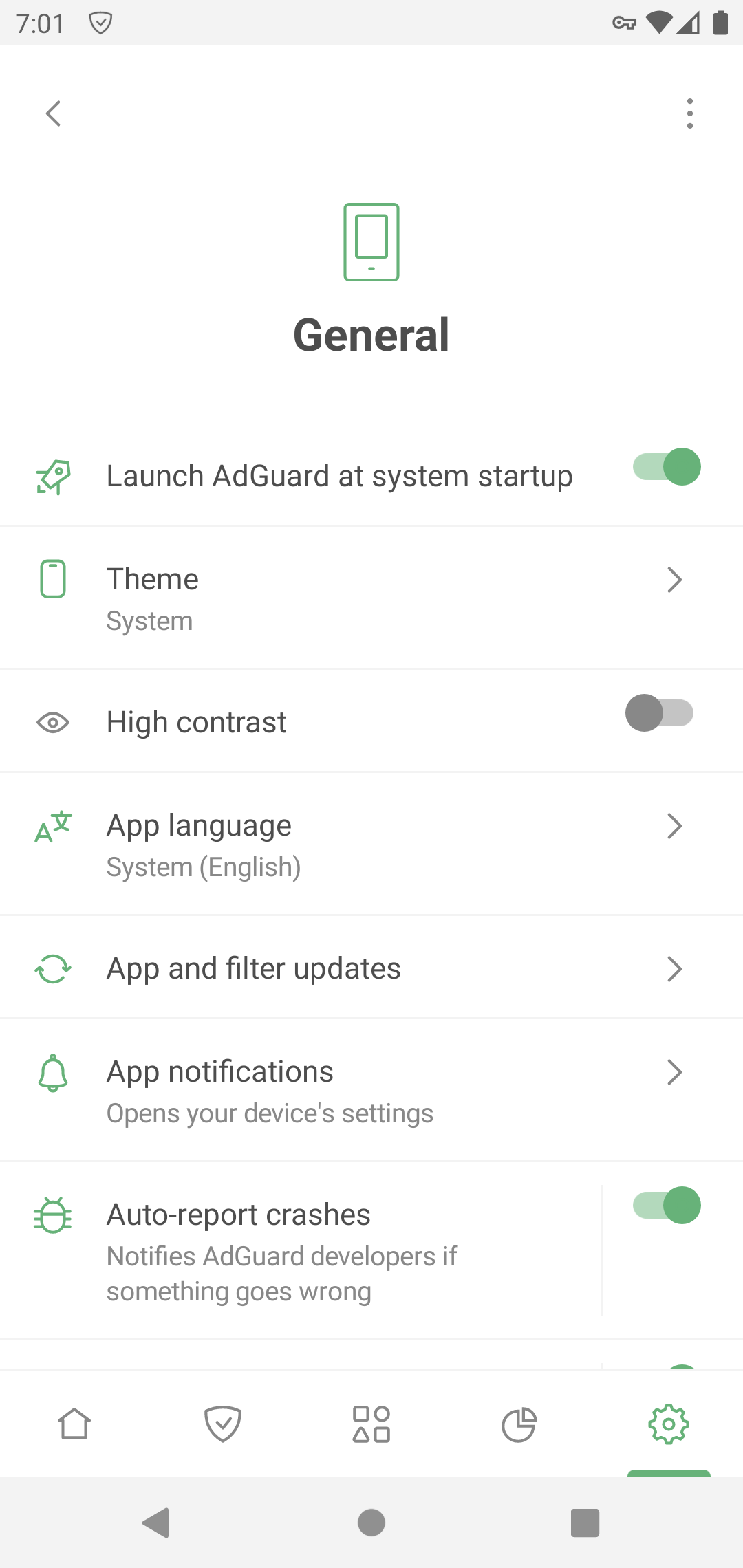
In Aggiornamenti dell'app e dei filtri, puoi configurare gli aggiornamenti automatici dei filtri e selezionare un canale di aggiornamento dell'app. Scegli Release per una maggiore stabilità, e Beta o Nightly per l'accesso anticipato a nuove funzioni.
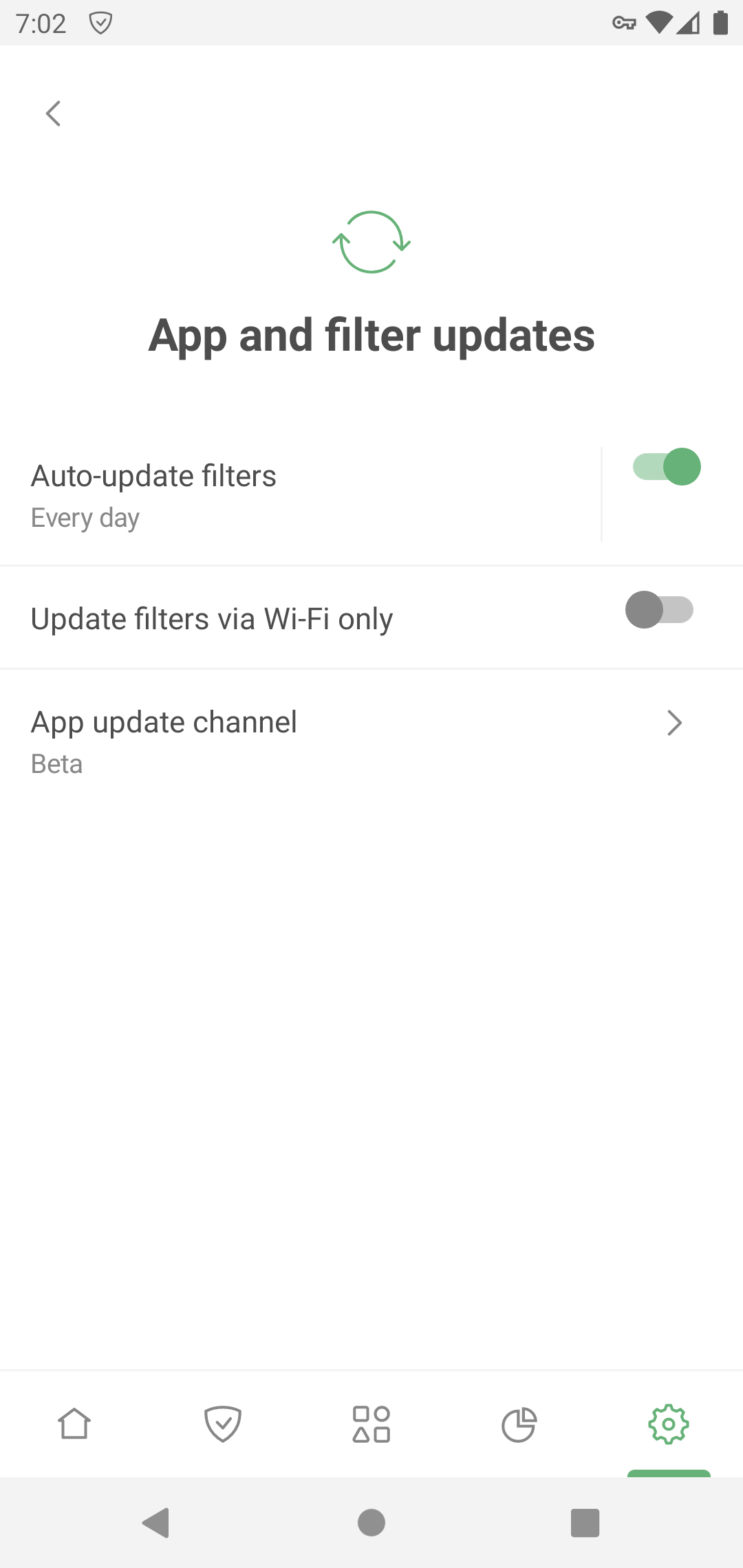
Impostazioni avanzate
Automatizzazione ti consente di gestire AdGuard tramite gestori attività.
Watchdog aiuta a proteggere AdGuard dall'essere disabilitata dal sistema (leggi di più sulla modalità di risparmio energetico di Android). Il valore che inserisci sarà l'intervallo in secondi tra i controlli del watchdog.
Il Livello di registrazione definisce quali dati sull'operazione dell'app devono essere registrati. Per impostazione predefinita, l'app raccoglie i dati sui suoi eventi. Il livello Debug registra più eventi: abilitalo se richiesto dal gruppo di AdGuard, per aiutarli a comprendere meglio un problema. Leggi di più su raccolta e invio dei registri
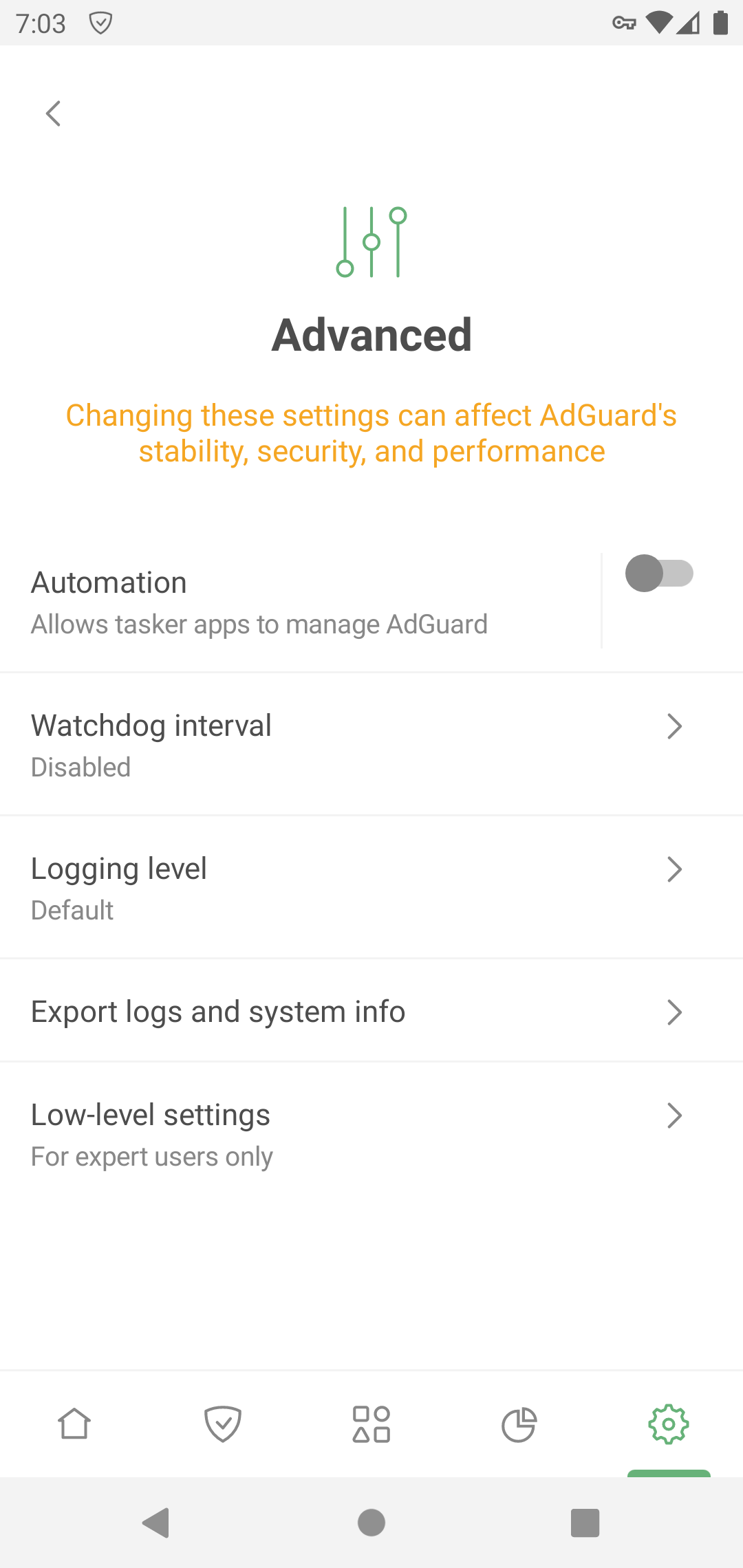
La sezione delle Impostazioni di basso livello è indirizzata agli utenti esperti. Read more about low-level settings
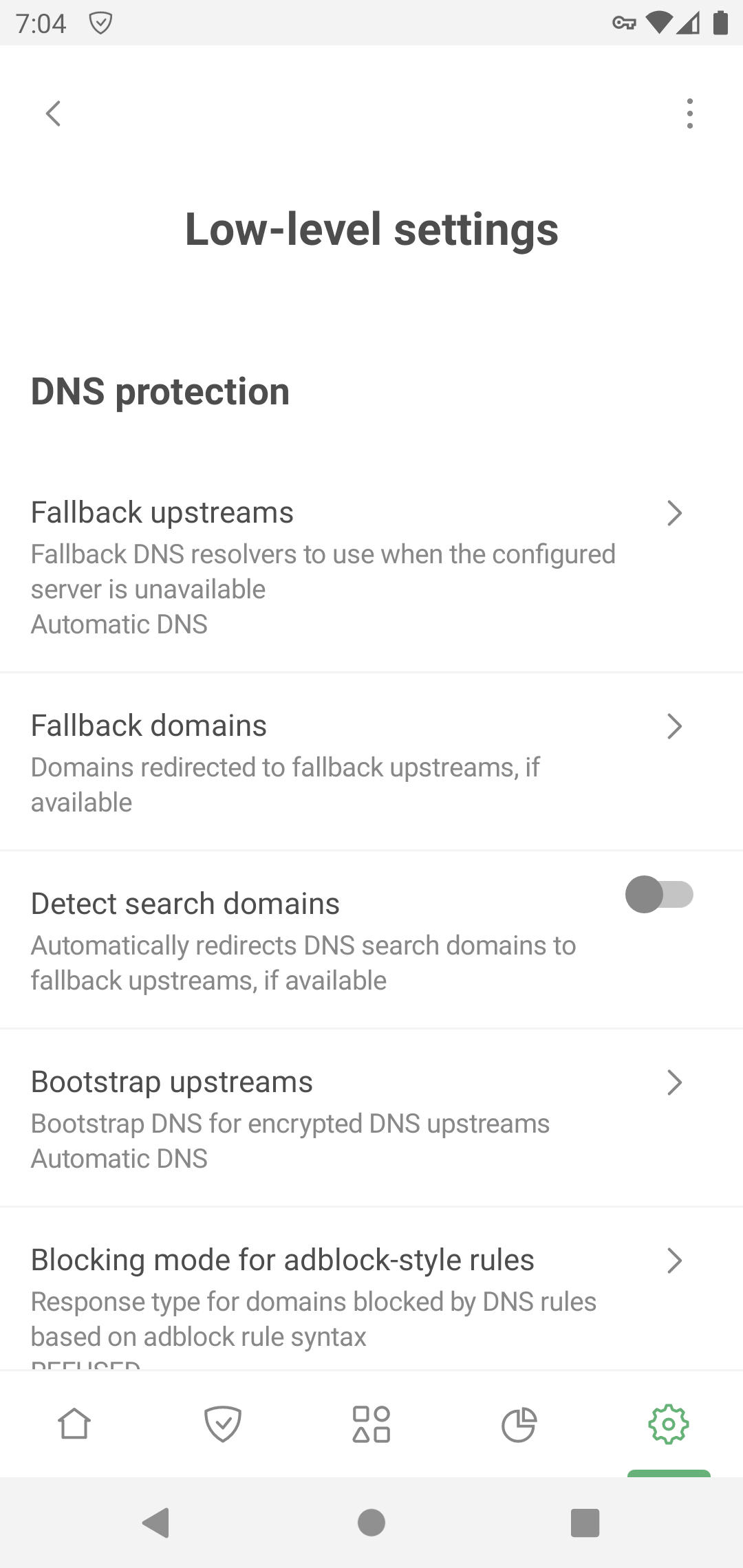
Filtraggio
Questa sezione ti consente di gestire le impostazioni di filtraggio HTTPS, i filtri e gli userscript, e a configurare il server di un proxy.
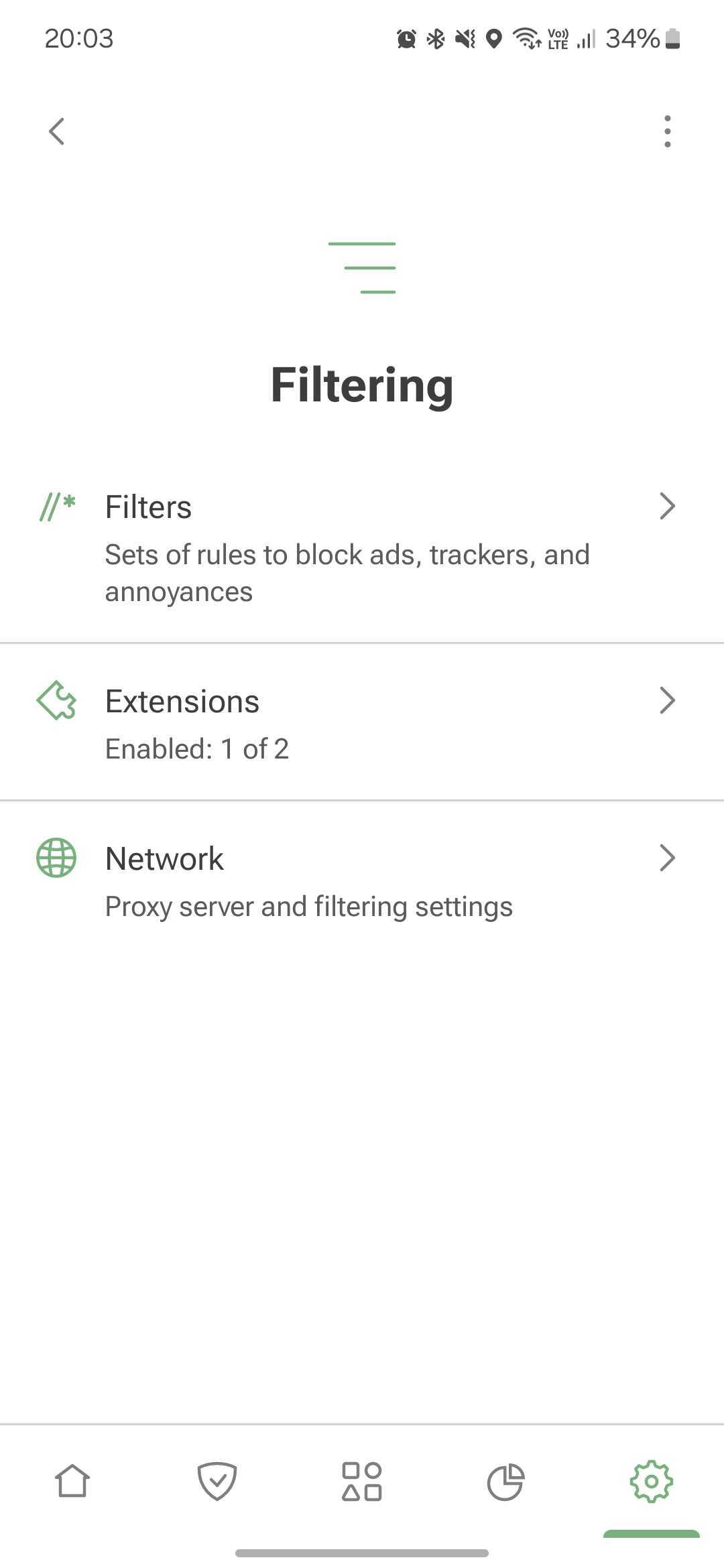
Filtri
AdGuard blocca inserzioni, tracciatori e fastidi, applicando le regole dai propri filtri. La maggior parte delle funzioni della sezione Protezione è alimentata da filtri AdGuard. Se abiliti la Protezione di base, questa attiverà automaticamente il filtro Base di AdGuard e il Filtro per Dispositivi. E viceversa: se disattivi entrambi i filtri, anche la Protezione di base sarà disabilitata.
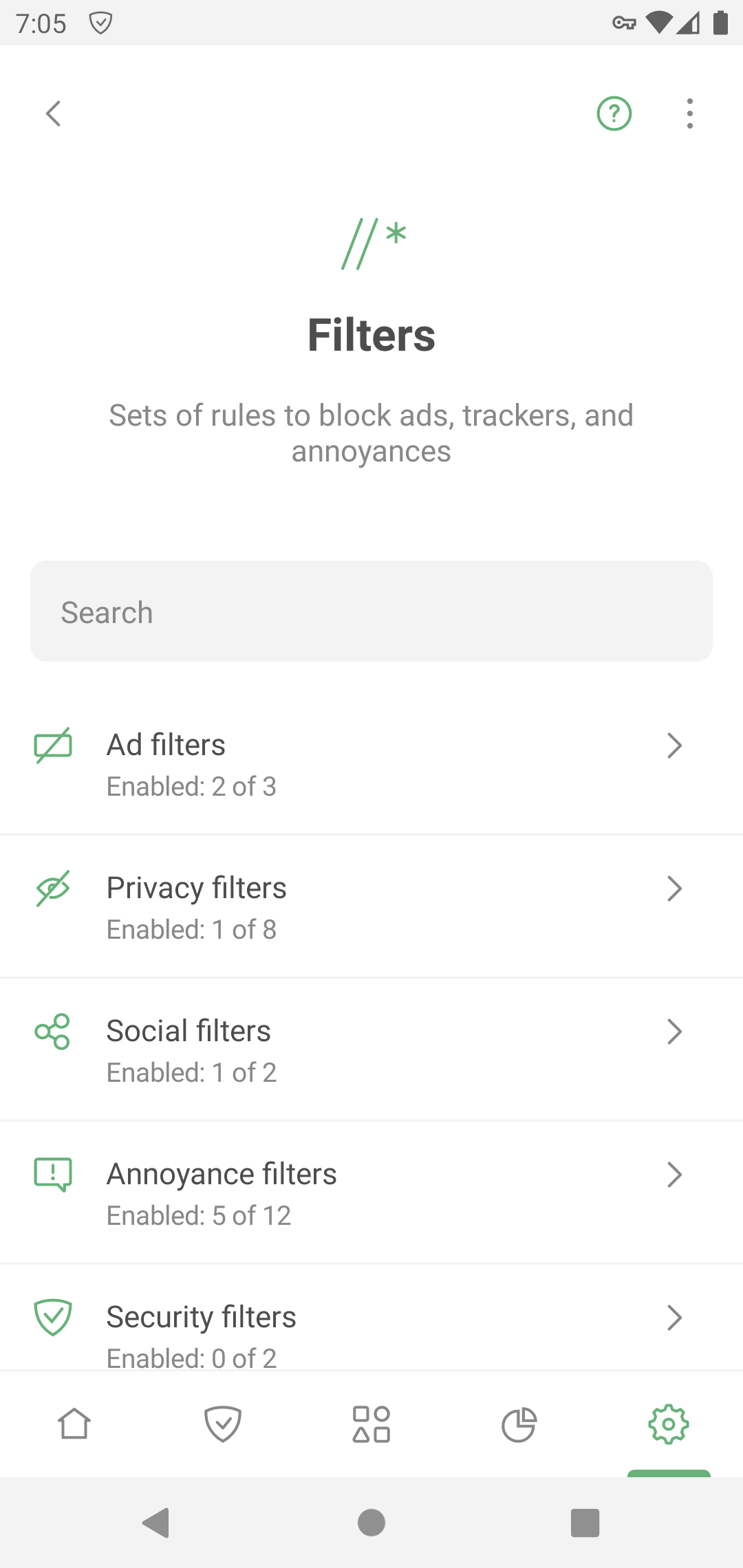
I filtri abilitati per impostazione predefinita sono sufficienti per il normale funzionamento di AdGuard. Tuttavia, se desideri personalizzare il processo di filtraggio delle inserzioni, puoi usare altri filtri di AdGuard o quelli di terze parti. Per farlo, seleziona una categoria e abilita i filtri desiderati. Per aggiungere un filtro personale, tocca Filtri personalizzati → Aggiungi filtro personale e inserisci il suo URL o il percorso del file.
Se attivi troppi filtri, alcuni siti web potrebbero non funzionare correttamente.
Estensioni
Extensions allow you to add userscripts and userstyles.
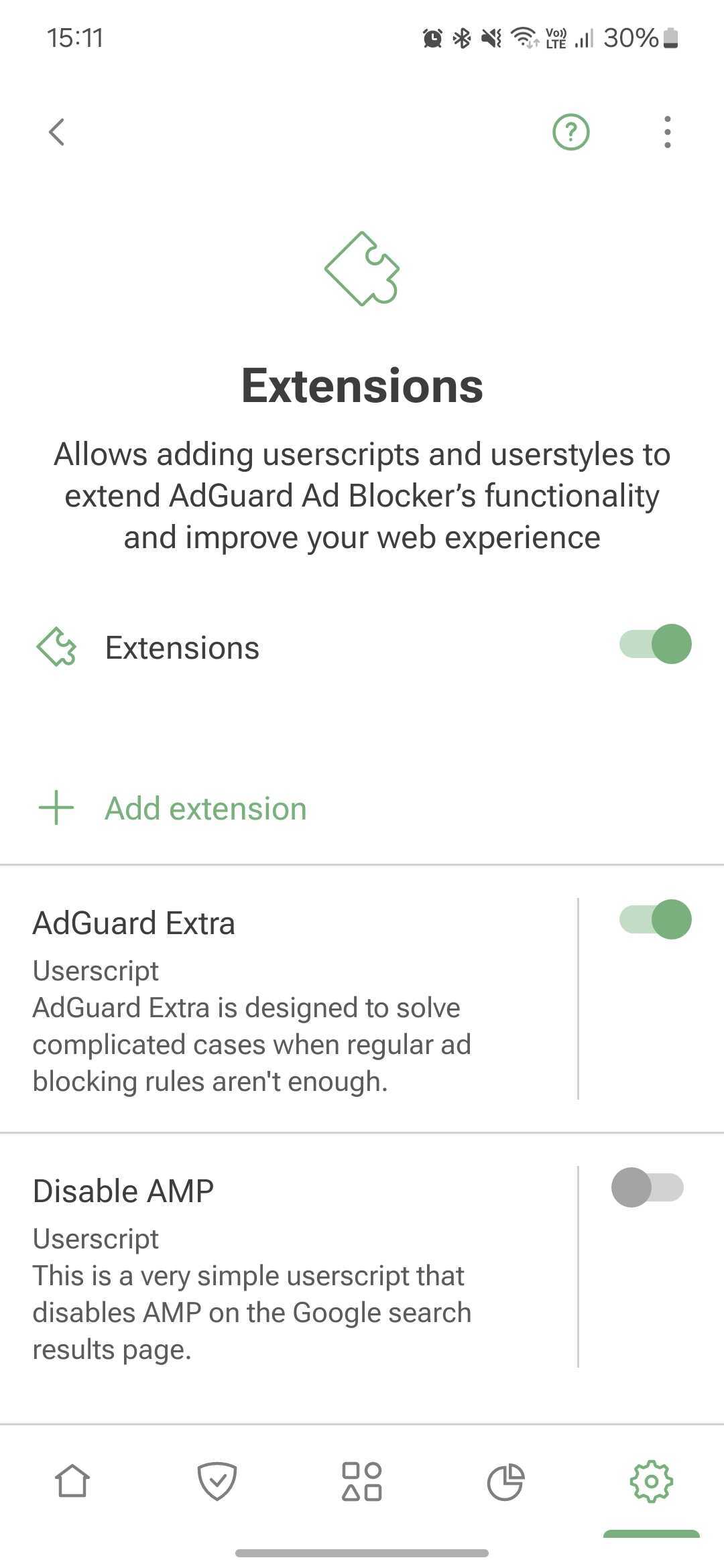
Userscripts are miniprograms written in JavaScript that extend the functionality of one or more websites. To install a userscripts, you need a special userscript manager. AdGuard has such a functionality and allows you to add userscripts by URL or from file.
Userstyles are like userscripts that allow you to change how web pages look in the browser without modifying their content. They work by adding CSS styles to the website’s existing styles. For example, if you want a dark theme on a website that doesn’t offer one, you can use a userstyle to do it.
To add a userstyle, go to Settings → Filtering → Extensions→ Add extension → Import from file or URL. You can find ready-made user styles online.
To create your own style, tap Add extension → Create userstyle.
AdGuard Extra
AdGuard Extra is a custom userscript that blocks complex ads and mechanisms that reinject ads to websites.
Disable AMP
Disable AMP is a userscript that disables Accelerated mobile pages on the Google search results page.
Rete
Filtraggio HTTPS
To block ads and trackers on most websites and in most apps, AdGuard needs to filter their HTTPS traffic. Read more about HTTPS filtering
Security certificates
To manage encrypted traffic, AdGuard installs its CA certificate on your device. It's safe: the traffic is filtered locally and AdGuard verifies the security of the connection.
On older versions of Android, the certificate is installed automatically. On Android 11 and later, you need to install it manually. Installation instructions
The CA certificate in the user store is enough to filter HTTPS traffic in browsers and some apps. However, there are apps that only trust certificates from the system store. To filter HTTPS traffic there, you need to install AdGuard's CA certificate into the system store. Instructions
HTTPS-filtered apps
This section contains the list of apps for which AdGuard filters HTTPS traffic. Ti preghiamo di notare che l'impostazione è applicabile a tutte le app soltanto se disponi dei certificati CA sia nell'archivio utente che nell'archivio di sistema.
HTTPS-filtered websites
This setting allows you to manage websites for which AdGuard should filter HTTPS traffic.
HTTPS filtering allows AdGuard to filter the content of requests and responses, but we never collect or store this data. However, to increase security, we exclude websites that contain potentially sensitive information from HTTPS filtering.
You can also add websites that you consider necessary to exclusions by selecting one of the modes:
- Exclude specific websites from HTTPS filtering
- Filter HTTPS traffic only on the websites added to exclusions
By default, we also do not filter websites with Extended Validation (EV) certificates, such as financial websites. Se necessario, puoi abilitare l'opzione Filtra siti web con certificati EV.
Proxy
You can set up AdGuard to route all your device's traffic through your proxy server. How to set up an outbound proxy
In this section, you can also set up a third-party VPN to work with AdGuard, if your VPN provider allows it.
Under Apps operating through proxy, you can select apps that will route their traffic through your specified proxy. If you have Integration with AdGuard VPN enabled, this setting plays the role of AdGuard VPN's app exclusions: it allows you to specify apps to be routed through the AdGuard VPN tunnel.
Routing mode
This section allows you to select the traffic filtering method.
- Local VPN filters traffic through a locally created VPN. This is the most reliable mode. Due to Android restrictions, it is also the only system-wide traffic filtering method available on non-rooted devices.
The Local VPN mode doesn't allow AdGuard to be used simultaneously with other VPNs. To use another VPN with AdGuard, you need to reconfigure it to work in proxy mode and set up an outbound proxy in AdGuard. For AdGuard VPN, this is done automatically with the help of the Integrated mode.
- Automatic proxy is an alternative traffic routing method that does not require the use of a VPN. One significant advantage is that it can be run in parallel with a VPN. This mode requires root access.
Please note that DNS filtering will still be active in Automatic proxy routing mode, and your device may not be able to filter DNS requests from specific apps. In VPN routing mode, apps are excluded from the local VPN by system means. Therefore, the system resolver sees which apps are included in the VPN and which are not. It either allows them into the local VPN or lets them bypass it. However, DNS requests come from the system resolver, not the application. In Automatic proxy mode, it is only possible to exclude traffic from applications, not their DNS queries, because AdGuard sees them as system queries.
- Manual proxy involves setting up a proxy server on a specific port, which can then be configured in Wi-Fi settings. This mode requires root access for Android 10 and above.
Licenza
In this section, you can find information about your license and manage it:
- Buy an AdGuard license to activate the full version's features
- Log in to your AdGuard account or enter the activation code to activate your license
- Sign up to activate your 14-day trial period. The activation code can be used on different devices and platforms
- Refresh the license status from the three-dots menu (⋮)
- Open the AdGuard account to manage your license there
- Reset your license — for example, if you've reached device limit for this license and want to apply another one
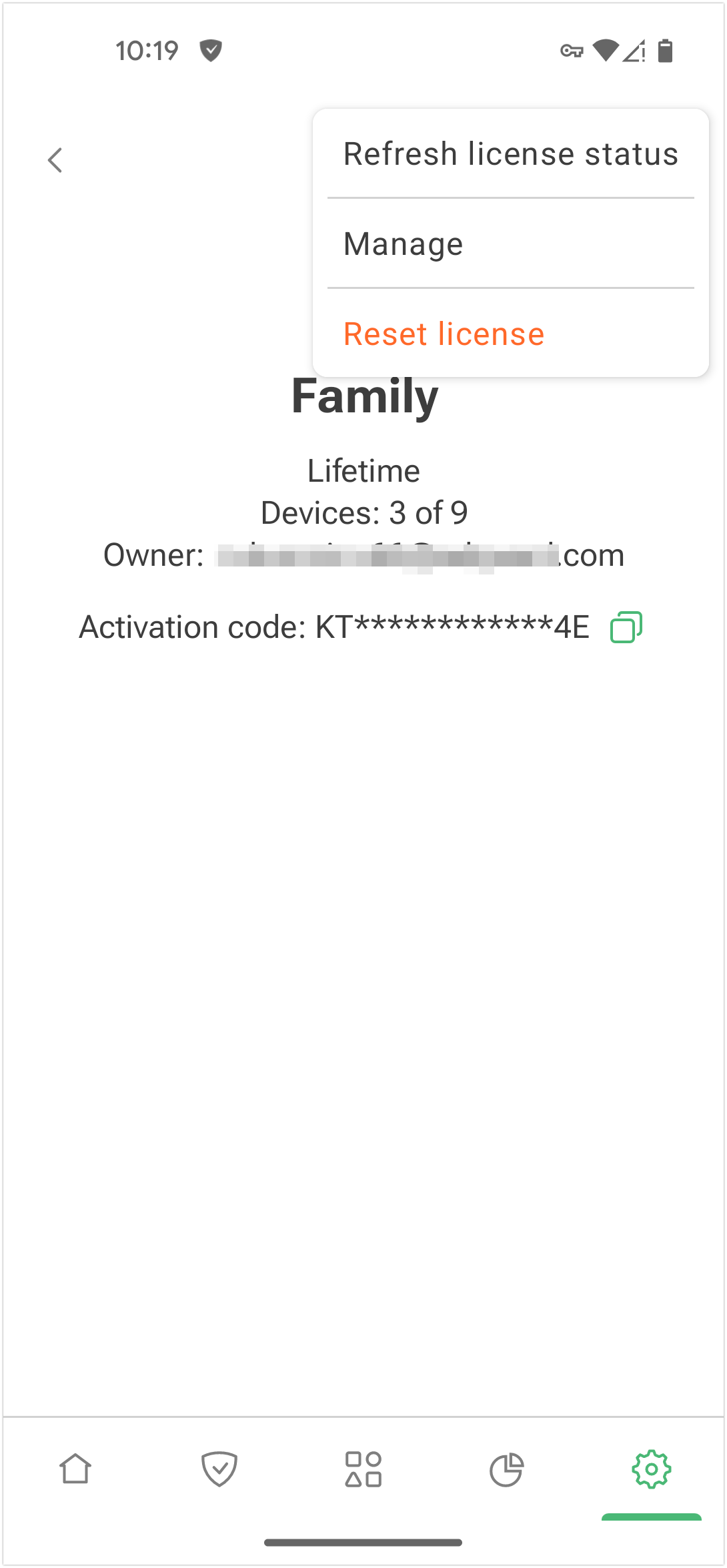
Supporto
Use this section if you have any questions or suggestions regarding AdGuard for Android. We recommend consulting FAQ or this knowledge base before contacting support.
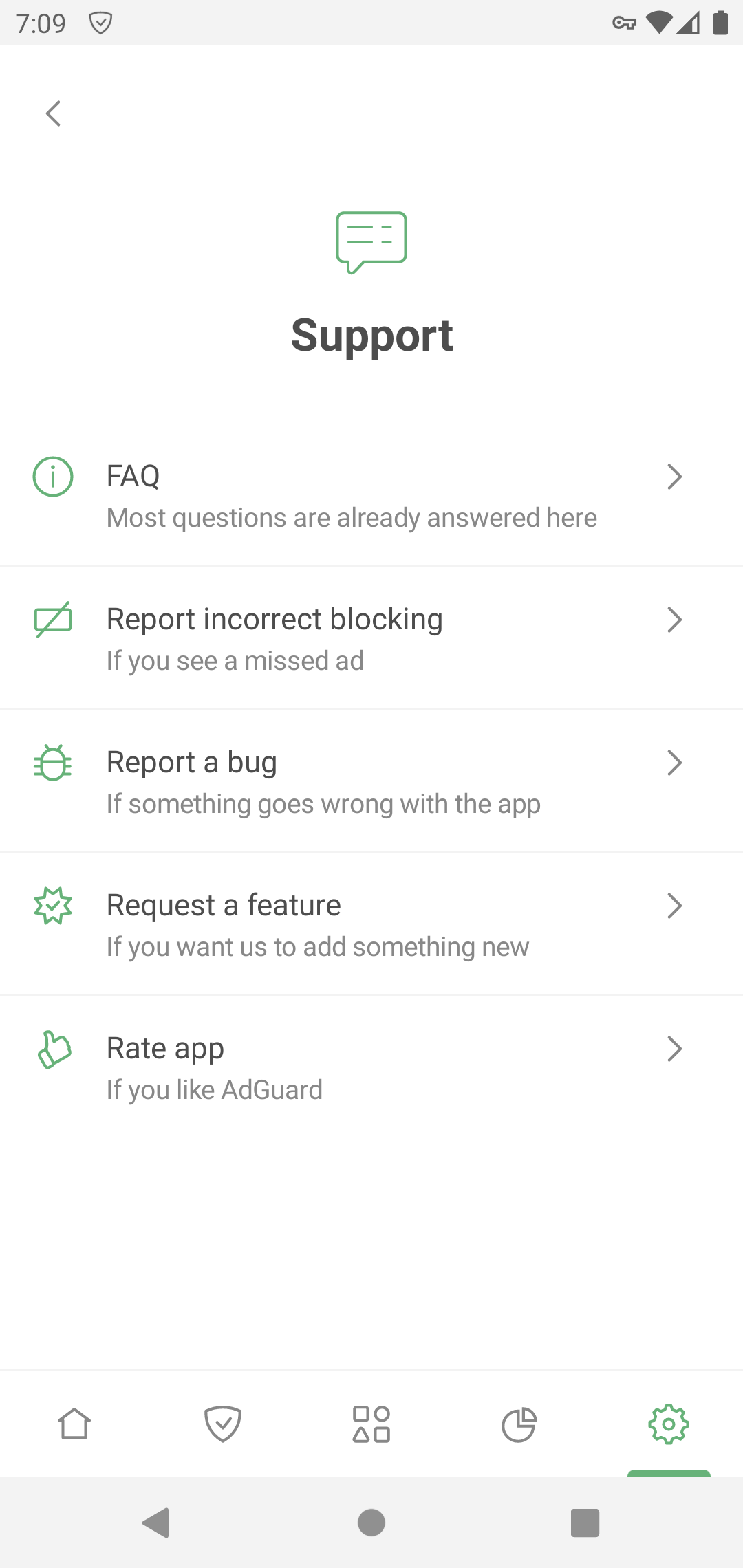
If you notice a missed ad, please report it via Report incorrect blocking.
For unexpected app behavior, select Report a bug. If possible, describe your problem in detail and add app logs. How to describe an issue
For your suggestions, use Request a feature.
GitHub is an alternative way to report bugs and suggest new features. Instructions and repository links